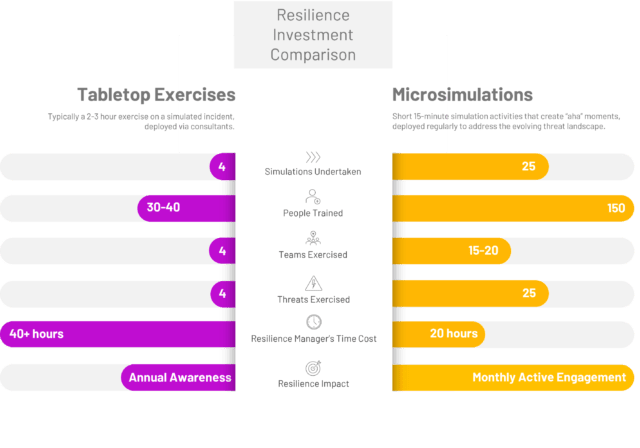As any resilience manager knows, experience is often the best teacher. Every business faces uncertain times, unexpected external or internal challenges, and outright security threats. That’s why you utilize Business Continuity tabletop exercises to simulate possible threats. However, too many resilience practitioners are still conducting these exercises “the old way.”
In other words, they’re relying on time and labor-intensive exercises to simulate a mere fraction of the threats that their business will face. Beyond that, traditional tabletop exercises require physical participation in an increasingly remote world. And let’s not forget the cost of bringing in a consultant to ensure the exercises are conducted properly.
It’s all just too much of a production, and the bang simply isn’t worth the buck.
Microsimulations vs Tabletop Exercises
That’s why at iluminr, we’ve developed the award-winning Microsimulations as an efficient and effective alternative to traditional tabletop exercises.
Microsimulations are 15-minute crisis scenario exercises that allow every employee in your org to respond to a single aspect of a simulated incident. Brief, remotely accessible exercises like these are essential in building employee confidence and capability, engaging a larger portion of your staff, and exercising a wider range of possible threats.
To that end, we put together an infographic (see below) comparing the potential ROI of tabletop exercises against that of microsimulations.
 Based on a $50,000 investment
Based on a $50,000 investment
Below, we make our case for microsimulations by offering 5 things that should give you pause next time you go to plan a BCP tabletop exercise.
1. Crisis fatigue
Let’s get one thing straight, right from the jump: we’re all tired. And not tired in a way that a cup of coffee and stiff breeze can fix. But tired of all the turmoil and upheaval of the last few years. Between COVID, social justice issues, political conflicts, major data hacks, and just plain old natural disasters, we’ve all had enough uncertainty for one lifetime. This is the first thing you need to consider when it comes to planning a BCP tabletop exercise.
Yes, you need to meet certain compliance requirements. But submitting your staff to multi-hour disaster scenarios may not always be the best way to go about it. Microsimulations break the simulated crisis down into its component parts, allowing the user to respond quickly to a single aspect of the hypothetical incident. This way, they’re more likely to be engaged and less likely to be overwhelmed by the magnitude of yet another crisis, albeit a fabricated one.
2. The capability gap
Consistency is key. If one day you tell me the capital of Azerbaijan is Baku, it will be a fun fact that floats around my head for maybe a day or two. But 6 months down the line, when you ask me the capital of Azerbaijan, I won’t have the faintest clue what you’re on about. Conversely, if you were to tell me every few days or weeks that the capital of Azerbaijan is Baku, odds are I’m going to recall the correct answer when prompted.
It’s simple muscle memory. The more often you do something, the more ingrained it becomes in your mind. This is where microsimulations can be more effective than tabletop exercises. Regularly deployed snack-sized simulation activities can help the participant more easily understand and know how to respond to the threat landscape. You’re improving their response capability through repetition.
3. The people problem
Tabletop exercises allow you to simulate a specific threat and employ a business continuity strategy for that particular scenario. At a high level, they’re an effective tool for your executive team and key stakeholders to be aware of the primary threats to your business and have a response plan ready.
However, these exercises have their limitations. As they require in-person participation, it’s near impossible to execute tabletops at scale, leaving a large portion of your staff underprepared. In our infographic above, you can see that we were able to train 4 teams and 30-40 people using tabletop exercises. Microsimulations on the other hand, enabled us to train 5x the amount of teams and members of staff.
You also have to consider your employee churn rate. If you’ve had larger than normal staff upheaval in the past year, then you’re going to have a large portion of staff that missed the exercise entirely. This is especially problematic for new team members who will have zero preparedness for any potential crisis situation.
4. Threats Assessed
Tabletop exercises may fail to address the wide range of potential threats that your business could face. In our resilience investment comparison, we were able to undertake 4 tabletop simulations, assessing four threats. However, using microsimulations, we increased the number of threats exercised to 25. Microsimulations therefore allow for less in-depth, but more widespread coverage of potential threats. In that regard, they are a great tool for building organizational confidence around crisis preparedness.
5. The bottom line
While it’s imperative that you prepare your business for any number of possible threats, you need to always be conscious of the investment you’re making into business resilience. At the end of the day, you shouldn’t overly disrupt the normal flow of business. Tabletop exercises require more time to plan and execute than many of your key stakeholders can afford to give up. You can emphasize crisis preparedness, but not at the expense of the bottom line.
As such, microsimulations are a wonderful alternative to tabletop exercises. They fit easily into your employee’s diaries and can be exercised remotely, allowing for much more flexibility. You’re increasing capability, while still being conscious and respectful of your staff’s time.
In Closing…
Microsimulations are an easy, efficient alternative to traditional tabletop exercises. Tabletop exercises have their place, but they are less conducive to employee engagement and can be disruptive to your business. If you want to increase employee confidence and preparedness for a wide range of threats, consider including microsimulations in your resilience toolset.
To help resilience champions get started on Microsimulations, we’ve developed Resilience Fundamentals – a set of 6 Microsimulations utilizing media clips and carefully curated tasks that gamify the experience and create “aha” moments. Check it out here.
We’d love to help you re-engage your people and bring resilience to life at your organization.














